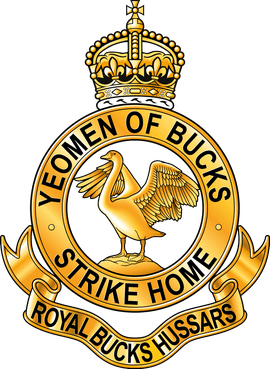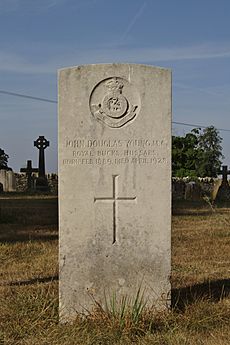Royal Buckinghamshire Yeomanry facts for kids
Quick facts for kids Royal Buckinghamshire Yeomanry |
|
|---|---|

Cap badge of the Yeomanry
|
|
| Active | 1794–present |
| Country | |
| Branch | |
| Type | Yeomanry (First World War) Royal Artillery (Second World War) Operational Hygiene Squadron (current) |
| Role | Operational Hygiene Squadron |
| Size | Three Regiments (First World War) One Regiment (Second World War) One Squadron (current) |
| Garrison/HQ | Aylesbury |
| Engagements | Second Boer War First World War Second World War |
| Commanders | |
| Notable commanders |
Richard Plantagenet, 2nd Duke of Buckingham and Chandos (1797-1861), Colonel of the Buckingham Yeomanry Cavalry, 1841 |
The Royal Buckinghamshire Yeomanry is a special unit in the Royal Logistic Corps. It started as a cavalry unit in 1794. Over time, it also served as artillery and in communications roles. Today, it is known as 710 (Royal Buckinghamshire Hussars) Operational Hygiene Squadron.
Contents
Early Days: French Wars (1794-1815)
In 1794, the British government was worried about an invasion from France. So, they passed a law called the Volunteer Act. This law encouraged wealthy people to create their own volunteer army groups. The idea was to have a force of volunteer cavalry, called Yeomanry. These groups could help defend the country or stop local unrest.
A meeting in Aylesbury on May 3, 1794, decided to form such a group in Buckinghamshire. Soon, several Buckinghamshire Armed Yeomanry troops were created. These were in places like Amersham, Aylesbury, and High Wycombe. Rich people like the Earl of Chesterfield often paid for most of the costs.
After a short peace in 1802, fighting started again with France. In 1803, the separate Yeomanry troops in Buckinghamshire joined together. They formed three regiments: the 1st, 2nd, and 3rd Regiments of Buckinghamshire Cavalry.
The 19th Century: Changes and Challenges
After the Battle of Waterloo in 1815, many volunteer groups were disbanded. But the Buckinghamshire regiments chose to keep serving. In 1827, the government stopped funding the Yeomanry. The 1st and 3rd Regiments were disbanded. The 2nd Regiment survived because a rich person, the Marquess of Chandos, paid for it.
However, new civil unrest, like the Swing Riots, made the government change its mind. Funding was brought back in 1830. The 2nd Regiment became the 2nd Buckinghamshire Yeomanry Cavalry. It even had two cannons! This regiment helped deal with riots in places like Otmoor and Hounslow Barracks.
In 1844, Queen Victoria visited the Duke of Buckingham. The regiment dressed up in fancy Hussar uniforms for her. The next year, the Queen gave the regiment the title 'Royal'. It became the 2nd Royal Bucks Regiment of Yeomanry Cavalry. By 1850, they were known as the Buckinghamshire Yeomanry Cavalry (Royal Bucks Hussars). They wore Hussar uniforms all the time.
In 1848, the Royal Bucks helped during the Chartist protests. They took over duties at Windsor Barracks. This allowed regular soldiers to go to London. By 1850, the Royal Bucks had eight troops. In 1875, their cannons were removed, and the gun troop became cavalry.
Towards the end of the 19th century, Yeomanry regiments were grouped into brigades for training. The Buckinghamshire Yeomanry joined with the Queen's Own Oxfordshire Hussars. They formed the 2nd Yeomanry Brigade.
Imperial Yeomanry: The Boer War
Fighting in South Africa
In 1899, the Second Boer War began in South Africa. After some tough losses, the British government needed more soldiers. On December 24, 1899, a special order created the Imperial Yeomanry. This allowed volunteer forces to fight overseas.
Existing Yeomanry regiments were asked to provide companies of about 115 men. Many British citizens volunteered. They trained while waiting to go to South Africa. The first group of volunteers arrived between February and April 1900.
The Buckinghamshire Yeomanry helped create four companies for the Imperial Yeomanry:
- 37th (Buckinghamshire) Company
- 38th (High Wycombe) Company
- 56th (Buckinghamshire) Company
- 57th (Buckinghamshire) Company
Lord Chesham, who led the Buckinghamshire Yeomanry, was put in charge of an Imperial Yeomanry battalion. For their service, the regiment earned the battle honour 'South Africa'.
In 1901, the regiment was renamed the Buckinghamshire Imperial Yeomanry (Royal Bucks Hussars). It was organized into four squadrons and a machine gun section. In 1908, it became the Buckinghamshire Yeomanry (Royal Bucks Hussars) and joined the Territorial Force. They were trained and equipped like Hussars.
World War I (1914-1918)
When World War I started in August 1914, the Territorial Force was meant for home defense. But many members volunteered to serve overseas. So, units were split into "1st Line" (for overseas service) and "2nd Line" (for home service). A "3rd Line" was also formed to train new soldiers.
1/1st Royal Buckinghamshire Yeomanry
The 1st Line regiment joined the 2nd Mounted Division in November 1914. They helped defend the coast in Norfolk. In April 1915, the division moved to Egypt.
In August 1915, the regiment gave up their horses and fought on foot in the Gallipoli Campaign. They landed at Suvla Bay and fought in the attack on Scimitar Hill. They suffered many losses.
After Gallipoli, the regiment returned to Egypt. They got new horses and were reorganized. They joined the Imperial Mounted Division in January 1917. They fought in the First and Second Battles of Gaza. They also took part in the Third Battle of Gaza, including the Battle of Beersheba. They helped capture Jerusalem in November 1917.
In April 1918, the regiment changed roles again. The Royal Buckinghamshire Hussars and the Berkshire Yeomanry joined to form C Battalion, Machine Gun Corps. This new unit was sent to France. In August 1918, it was renamed 101st (Bucks. & Berks. Yeo.) Battalion, Machine Gun Corps. They fought on the Western Front until the war ended.
2/1st Royal Buckinghamshire Yeomanry
The 2nd Line regiment was formed in Buckingham in September 1914. It stayed in the United Kingdom for home defense. In July 1916, many 2nd Line Yeomanry units became cyclists. The 2/1st Royal Buckinghamshire Yeomanry remained mounted for a while. But in August 1917, it also became a cyclist unit. It was based at Canterbury until the end of the war.
3/1st Royal Buckinghamshire Yeomanry
The 3rd Line regiment was formed in 1915. Its job was to train new soldiers. It was later absorbed into another reserve cavalry regiment.
Between the World Wars
In 1920, the regiment was reformed in the Territorial Army. Its headquarters was still in Aylesbury. After World War I, most Yeomanry regiments changed roles. On April 29, 1921, the Royal Buckinghamshire Yeomanry joined with the Berkshire Yeomanry. They became an artillery unit called 99th (Buckinghamshire and Berkshire) Brigade, RFA.
Within this new unit, the Buckinghamshire Yeomanry kept its identity. It formed two artillery batteries: 393 (Royal Bucks Yeomanry) Battery and 394 (Royal Bucks Yeomanry) Battery.
Over the years, the unit's name changed a few times. In 1924, it became 99th (Buckinghamshire and Berkshire Yeomanry) (Army) Field Brigade, RA. In 1938, it became 99th (Buckinghamshire and Berkshire Yeomanry) Field Regiment, RA.
By 1939, another war seemed likely. The Territorial Army was doubled in size. The Berkshire and Buckinghamshire Yeomanry separated on August 25, 1939. The Buckinghamshire group became 99th Field Regiment, Royal Artillery.
World War II (1939-1945)
When World War II began in September 1939, the 99th Field Regiment, Royal Artillery, was ready. It was sent to France in January 1940 as part of the BEF. They fought in France and Belgium.
After the Dunkirk evacuation, the regiment returned to England. It was reorganized into three batteries. In June 1942, the regiment was sent to the Far East. They joined the 2nd Division and served in India and Burma. They fought in important battles like the Arakan, Kohima, Imphal, and Mandalay.
After the war ended in 1945, they returned to India. The regiment was put into "suspended animation" in 1946. This means it stopped active service but could be brought back.
After the Wars: Postwar Changes
The regiment was reformed in 1947 as the 299th (Royal Buckinghamshire Yeomanry) Field Regiment R.A.. In 1950, it joined with the Queen's Own Oxfordshire Hussars. It became the 299th (Bucks and Oxfordshire Yeomanry) Field Regiment, R.A..
There were more mergers in the 1950s and 1960s. In 1967, the regiment was reduced to a smaller unit called P Battery (Royal Bucks Yeomanry) The Buckinghamshire Regiment, R.A. (T). In 1971, it changed roles again and became an infantry unit. Later, the Royal Buckinghamshire title was taken by a signal squadron.
Modern Day Role
Until 2014, 1 (Royal Buckinghamshire Yeomanry) Signal Squadron was a special communications unit. They provided important communications in different parts of the world. This unit had both full-time and part-time soldiers.
On January 1, 2014, a new unit was formed: 710 (Royal Buckinghamshire Hussars) Operational Hygiene Squadron. This unit is part of the Royal Logistic Corps. Its job is to provide hygiene support, which is a very important role for the army.
Battle Honours
Battle honours are special awards given to military units for their bravery in battles. The Royal Buckinghamshire Yeomanry has earned many battle honours:
- Second Boer War
- World War I
Arras 1918, Scarpe 1918, Ypres 1918, Courtrai, France and Flanders 1918, Suvla, Scimitar Hill, Gallipoli 1915, Egypt 1915–17, Gaza, El Mughar, Nebi Samwil, Palestine 1917–18
- World War II
The Royal Artillery, which the Yeomanry was part of, fought in almost every battle. In 1833, King William IV gave the Royal Artillery the motto Ubique. This Latin word means "everywhere." It was given instead of listing all their battle honours, because they fought in so many places.
See also
- Imperial Yeomanry
- List of Yeomanry Regiments 1908
- Yeomanry
- Yeomanry order of precedence
- British yeomanry during the First World War
- Second line yeomanry regiments of the British Army
- List of British Army Yeomanry Regiments converted to Royal Artillery


